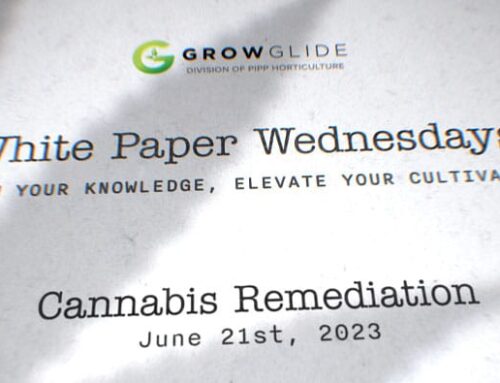
“I figure if I study high, take the test high, get high scores! Right?” – Redman (as Jamal King in 2001’s “How High”)
HOW HIGH DO YOU WANT TO GET?
Plant high, grow high, and everyone gets higher…right?
High racks, high ppfd, high Co2, high level of control = high price per pound…right?
High COAs = High EBITDA…right? LOL not always
All jokes aside, indoor CEA cultivation is driven by science in order to understand the complex interaction of a multitude of cultivation parameters. This allows us to optimize the production of plants and increase efficiency. We continuously strive to produce more biomass, and more secondary metabolites, get the most from every photon, and make sure every watt and labor hour has maximum impact.
What have we learned from years of research? We need to get high for a cultivation to make operational sense.
Literally, to get high, we need to grow vertically to utilize the cubic space available in food deserts and cannabis cultivation facilities. This lowers fixed cost absorption and increases the power of the dollars we spend to build these facilities. Single-tier room utilization traditionally referred to as 70-80% is actually around 27% room utilization when you factor in the cubic footage of the room. This depends on ceiling height, but how can you not consider ceiling height?!
That airspace is valuable and shouldn’t be ignored. Let’s take the real estate market in New York as an example. It’s all about rights to use the airspace above the existing building; it makes the building worth 5-10x if you get air rights. The same goes for cannabis and food crops. Going vertical makes production per square foot offset additional CapEx and helps the asset you build be worth more in the long run.
While it might take time to dial in every cultivar in the stable to get 35% THC and 4% terps, it is possible and that is the race. More canopy means more cannabinoids and terpenes for extraction, more consumer packaged goods, more drinks, more brand awareness, and higher profit margins. And as you balance out the cardinal parameters of your environmental itinerary relative to your cultivars you win awards, you gain customers, you get sell-through numbers, and your brand flourishes.
As a cultivator, it’s easy to say that increasing the canopy and going vertical reduces quality, but this is not true. It’s just harder to consistently push phenotypic expression to the max without the support of data and the mechanical solutions needed to support your SOPs. It’s harder to grow fire when tier spacing, PPFD, Airflow, dehumidification, VPD, Drybacks, IPM, defoliation, and all the other parts of a good grow have to be on point. But that is what separates the master grower from the novice. You have to have the tools, know how to use the tools, and understand the results of the action plans you recommend.
In the spirit of 4:20, here are our Top 9 How Highs every grower needs to consider.
How High should your racks go?
This is the room utilization metric that dramatically impacts operational efficiency. But there are many safety considerations, plant loading considerations, defoliation, IPM, and harvest considerations. More tiers = more canopy = more lights = more HVACD= more profits. Three tiers are likely the best plan for EBITDA and the lowest cost of production over time.
How high of a CFM with fans and other augmented airflow?
Have you considered the integrity of your envelope, have you done air balancing for your ductwork, do you know how many air exchanges you want per hour? There is a lot to consider and it depends on the goals, temperatures, PPM of CO2, VPD…it’s all connected. A .4-.7 M/s bottom-up airflow will break the boundary layer on the underside of the leaf and drive gas exchange, but higher might cause stomatal closure unless you have more CO2 and higher PPFD. Too much airflow might dry cuticular waxes on the plants’ surfaces and require a balance of fertigation to keep plants vital but this higher velocity might also mitigate microclimates and prevent the sporulation of powdery mildew.
How high for sensor accuracy/density?
This is the classic range versus resolutions argument. Do you want a few sensors that are incredibly accurate (resolution) or many sensors that are less accurate (range). It all depends on what your budget will allow and how you plan to use the tool. How granular do you need the data? How accurate do you need your airflow measurements, leaf temperature readings, and other influential metrics to be? Does this granular data lead to power action-plans or paralysis? What would you do with it if you had precision accuracy for all your cardinal parameters? In a research environment you want accuracy that illustrates the impact of every action. In a commercial cultivation environment accuracy is important, but with a process in place it might be more impactful to have more data points to average. This range helps to paint a mural versus the resolution that helps you paint your name on a grain of rice.
How high is leaf temperature and how important is VPD to you?
78F-82F is optimal for the cannabis plants’ metabolic rate, but what about early stages to control the stretch. Should you go lower? What about late-stage senescence to bring about color, should you go lower for bag appeal? Do you have the HVACD and airflow to even go lower or should you balance available performance with manageable expectations?
How high should I push my drybacks?
How accurately can you measure water volume in the media? How well can I control fertigation shot size? Can you augment root zone temperature to trigger the desired results? The specific metrics depend on the cultivar, media, goals, and ability to control the ambient conditions for every plan on every tier.
How high are your labor costs and how much do you want to automate?
People grow cannabis, not robots, but people and robots are both expensive. Automation is important, and SOPs are important, but skilled labor and training are key to running a commercial facility. Too much labor and costs of production skyrocket, too little labor and plants suffer, bottlenecks occur and your business will be less productive. Labor is a balance that is achieved through leadership, training, SOPs, and measurement. Facility management is not linear, it’s a series of informed action plans that guide KPIs and metrics that fuel goals and success.
How High Cost of production?
Can you survive market compression? Historically this was not that important. When cannabis sold for $4000/lb the cost of production didn’t matter because the margins were high. With market compression, the cost of production needs to be as low as possible to remain competitive. If it costs you $1000 to produce a pound and it costs your neighbor $500, at some point YOU become a distressed asset. What are you willing to invest in your facility to futureproof your margins?
How High is your wholesale price per pound?
How are you influencing your cultivar’s phenotypic expression to get the best results? COAs drive buyers to pay more, but brand awareness, consistency of customer experience, packaging, cannabis cups and awards, and unique cultivars all help add value to the finished product. It’s easy to say you want to grow fire but where do you invest the limited resources of money, time, and talent to capitalize? To do it to the max and consistently we need data, action plans, adherence to setpoints, and control.
How High is the capital raise needed to build your facility?
a. It’s easy to underestimate the financial investment to build a state-of-the-art facility, especially after working with the city, real estate, skilled trades, consultants, and everything else you need to prepare for success. Understanding what is most important at what phase allows you to get what you need one step at a time. The cannabis industry was built in tents, garages, and warehouses before it was able to come out of the closet. We have all learned a lot from historic facility design and taking a measured and phased approach might be the best way to implement success in today’s market. Build one great room at a time, make it as profitable as possible, and justify every penny you spend. Remember you aren’t trying to build the biggest facility you can as cheaply as possible, you are trying to build the best facility you can one rack at a time.
It’s easy to get confused in the emerging cannabis market, especially when times are tough. It’s hard to find balance between investing in science, trusting tribal knowledge, and focusing on your proforma…especially when you are high. Cultivators, researchers, engineers and entrepreneurs are all speaking different languages and value different investments that empower their individual confidences.
One thing that brings us all to the same page is that producing cannabis makes people happy, saves lives, creates jobs, and produces revenue. Any cannabis business that can clearly define its goals can lay out the metrics and KPIs that influence and guide their success. With this structure in place every scientist, cultivator, engineer and entrepreneur can evaluate the value of each investment and determine how HIGH they need to go for their business. Each business is different but those that can answer the why of every penny they spend get to stay in the industry and tell their story of the journey to the TOP.













Leave A Comment